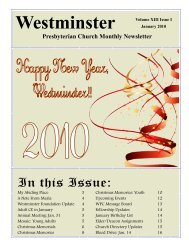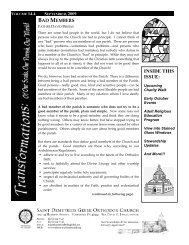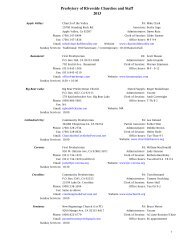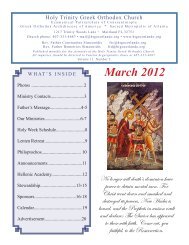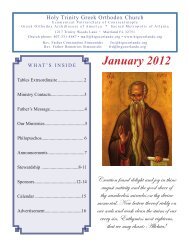OSIS? 2.0.1 User's Manual - Web services are running on AMBIB
OSIS? 2.0.1 User's Manual - Web services are running on AMBIB
OSIS? 2.0.1 User's Manual - Web services are running on AMBIB
You also want an ePaper? Increase the reach of your titles
YUMPU automatically turns print PDFs into web optimized ePapers that Google loves.
Esther with traditi<strong>on</strong>al verse elements, i.e., as c<strong>on</strong>tainers and others with the<br />
milest<strong>on</strong>eable verses. The reas<strong>on</strong> is quite simple, inc<strong>on</strong>sistent markup is more<br />
difficult to process and makes the encoded text less useful for every<strong>on</strong>e.<br />
This is equivalent to the TEI "milest<strong>on</strong>e" method for marking such phenomena. It has the<br />
advantage that milest<strong>on</strong>es representing a given type of element have the same name as<br />
the element, and automatically have the same attributes. Although XML itself will not<br />
detect a validati<strong>on</strong> error if attributes other than eID <str<strong>on</strong>g>are</str<strong>on</strong>g> specified <strong>on</strong> the ending<br />
milest<strong>on</strong>e, eID is specified <strong>on</strong> the starting milest<strong>on</strong>e, or the start and end milest<strong>on</strong>es <str<strong>on</strong>g>are</str<strong>on</strong>g><br />
in the wr<strong>on</strong>g order, each of these c<strong>on</strong>diti<strong>on</strong>s is an <str<strong>on</strong>g>OSIS</str<strong>on</strong>g> error.<br />
For <str<strong>on</strong>g>OSIS</str<strong>on</strong>g> purposes, there is no semantic difference between marking up a chapter or<br />
verse as a c<strong>on</strong>tainer using a start and end tag, versus marking it up as a "milest<strong>on</strong>e pair"<br />
c<strong>on</strong>sisting of two empty tags.<br />
Note: Typesetting and layout systems vary in their ability to accommodate n<strong>on</strong>hierarchical<br />
markup such as this. Fortunately, in most Bible editi<strong>on</strong>s the <strong>on</strong>ly formatting<br />
c<strong>on</strong>sequence of a verse element is inserti<strong>on</strong> of the verse number, and perhaps inserti<strong>on</strong> of<br />
a line-break; these <str<strong>on</strong>g>are</str<strong>on</strong>g> within the capabilities of most layout and style systems even<br />
though the verse is not a c<strong>on</strong>tainer in XML terms.<br />
12. Special Text Types<br />
The bulk of the remaining <str<strong>on</strong>g>OSIS</str<strong>on</strong>g> elements fall into a few simple classes: First, markup for<br />
special text types, such as epistles and drama. Sec<strong>on</strong>d, generic structures such as lists,<br />
tables and glossaries (typically found in appendixes of printed Bibles). And finally,<br />
small-scale elements that mark, quotati<strong>on</strong>s, notes, names, index entries, and the like.<br />
12.1. Markup for epistles and similar materials<br />
Letters, epistles, and similar texts <str<strong>on</strong>g>are</str<strong>on</strong>g> marked up in basically the same way as any other<br />
text. However, three special elements <str<strong>on</strong>g>are</str<strong>on</strong>g> available for marking porti<strong>on</strong>s unique to this<br />
genre:<br />
12.1.1. salute<br />
The salute element encloses the salutati<strong>on</strong> or greeting, typically at the very beginning of<br />
a letter. It should include the whole salutati<strong>on</strong>, including (if present) the "to", "from", and<br />
any following greeting or blessing. If the boundaries of a salutati<strong>on</strong> <str<strong>on</strong>g>are</str<strong>on</strong>g> the same as the<br />
boundaries of a paragraph, secti<strong>on</strong>, or other unit, that unit should be placed outside, with<br />
the salute element directly within. For example (LBP):<br />
<br />
The First Epistle to Timothy<br />



